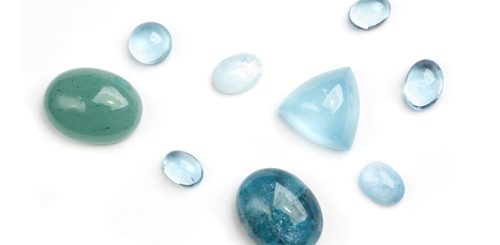Gemstone Spotlight: Aquamarine

Aquamarine is classified as a beryl gem, which includes stones such as morganite and emeralds. The term “aqua” is meant to denote the ocean colors that it displays, namely, blue and green. It is a truly fabulous gem, and although not as well-known as diamonds, emeralds or topaz, will sometimes have a greater value and rarity.
Aquamarine Origin and Characteristics
Even though aquamarine is related to emeralds, unlike emeralds it is typically inclusion free. Its bluish green coloration is the result of its iron content, and it can range in shades from a pale blue which is virtually colorless to a deep blue which is similar to the sea. The stronger an aquamarine’s color, the more it will cost. However, many collectors desire a clear blue since it enhances the brilliance and transparency of the stone.
There are a number of places where aquamarine is mined, including Mozambique, Madagascar, Pakistan and Brazil. Gems found in Madagascar are some of the most dazzling, and will display a shade which ranges from dark to light blue. The largest stones tend to be found in Brazil however. Other places where aquamarine can be found include the USA, Sri Lanka, Russia and India. By country, both Afghanistan and Pakistan seem to have the largest deposits. The gem thrives in any location where regular beryl is abundant. Aquamarine is also the March birthstone.
Aquamarine is not as hard a diamond, but has a respectable hardness which reaches about -7.5 within Mohs’ scale. This means that it offers outstanding durability and won’t scratch easily. This, aside from its beauty, is one of the reasons why many craftsmen like using it in jewelry. Fashion wise, it is exceptionally versatile and can be worn during the day or night. Because aquamarine isn’t as hard as other gemstones, it is easier to cut. Designers can therefore make any shapes or cuts they desire without too much trouble. This has made the gem more popular, and most jewelers will use the same cuts that are found with other gems, such as squares, cushions, rounds, ovals and pears.
Why You Should Buy Aquamarine Loose Rather Than Pre-Set
Many experts will recommend buying aquamarine loose rather than preset. The reason for this is because of choice as well as value. When purchased loose, the gems are more affordable, offer greater value and make it easier to know what you’re paying for. Sometimes jewelry will conceal inclusions, or may deepen the color. Loose stones are simpler to inspect so that their actual worth can be determined.
Loose gems also give you greater choices. You can select the specific color, shape and cut that you want, as well as the ideal setting, whether it is gold, silver or platinum. Aquamarine works well when used with diamonds as the accent. Loose gems are also the best choice for craftsmen who want to make their own jewelry.


